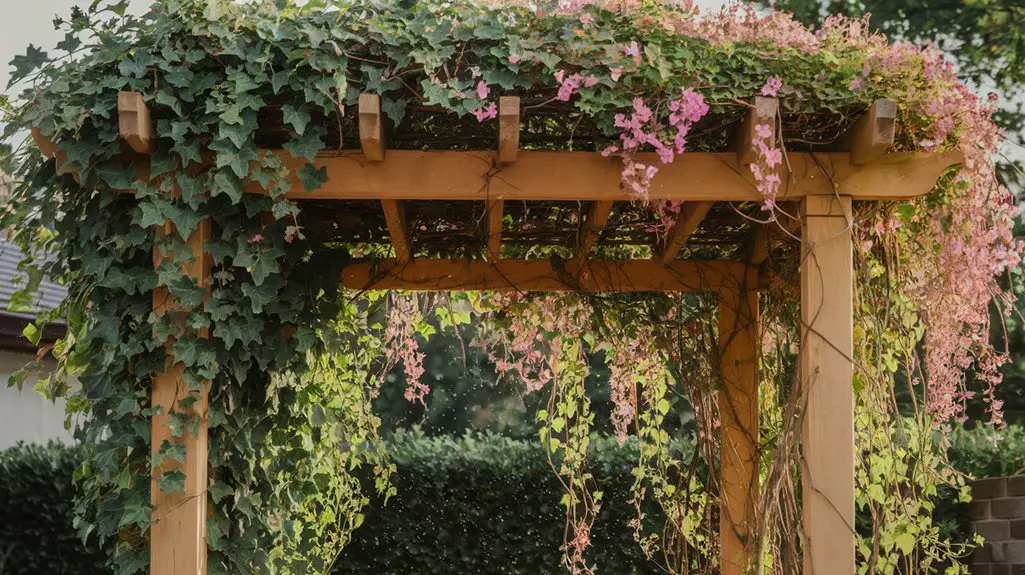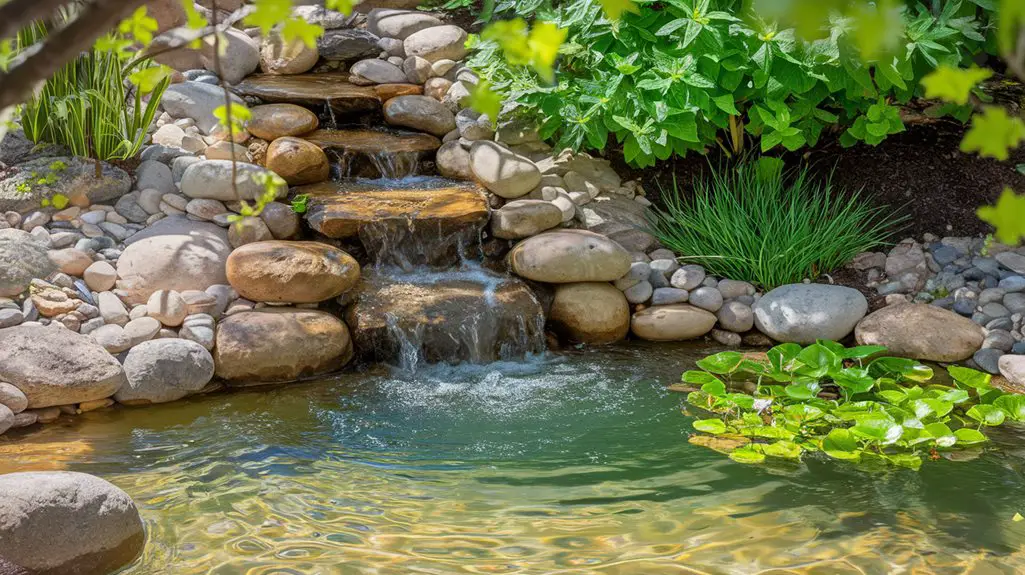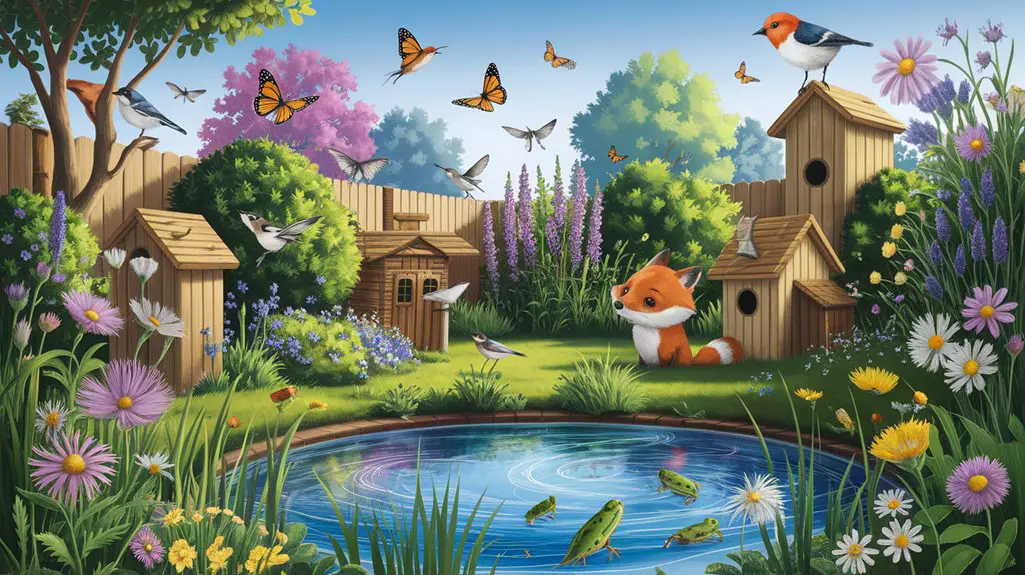A bare pergola stands like a skeleton in the garden, awaiting the transformative touch of life. You'll discover how climbing plants can breathe liveliness into your outdoor structure while solving multiple design challenges simultaneously. These botanical companions offer far more than mere decoration—they create functional microclimates, enhance privacy, and establish dynamic visual interest throughout changing seasons. The benefits extend well beyond aesthetics, touching on practical considerations that affect your everyday outdoor experience.
Natural Shade Creation Without Blocking Views
While traditional pergola coverings like fabric canopies and solid roofs provide immediate shade, climbing plants offer a more sophisticated approach to creating natural overhead protection.
You'll benefit from a dappled light effect that filters sunlight rather than blocking it entirely.
The organic canopy created by vines allows for strategic light penetration, maintaining visibility through your outdoor structure while reducing UV exposure and heat.
This natural filtering system adapts seasonally—deciduous climbers provide full shade in summer and allow warming sunlight during winter months when leaves drop.
Unlike solid coverings that create stark shade lines, climbing plants diffuse light gradually, creating subtle shifts between sunny and shaded areas.
This natural light gradient enhances spatial perception and preserves views of the sky, maintaining an open, airy atmosphere throughout your pergola space. Additionally, incorporating climbing plants can contribute to improving air quality, as they naturally filter pollutants and enhance the overall environment.
Year-Round Visual Interest Through Seasonal Changes
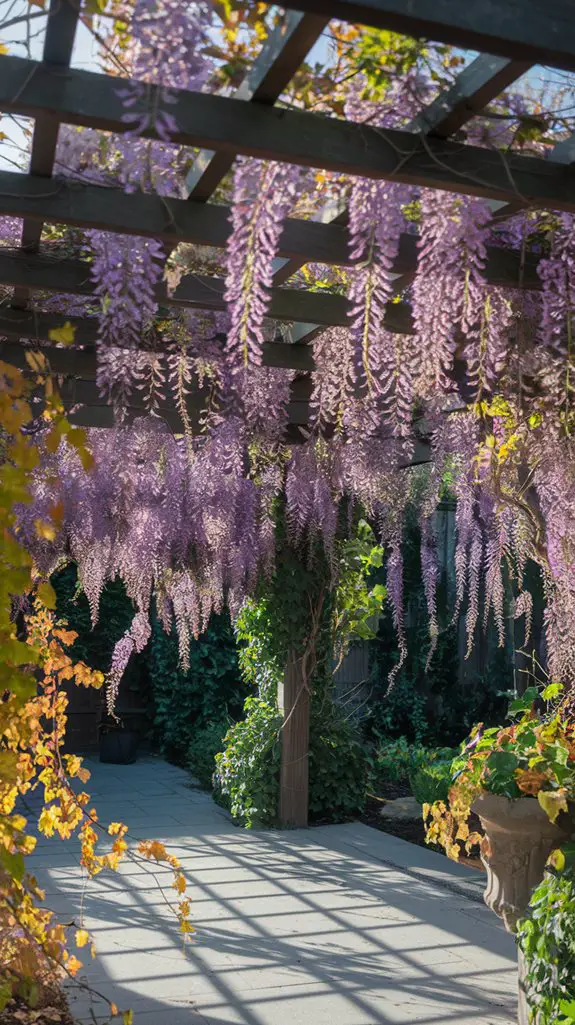
Unlike static pergola structures, climbing plants transform your outdoor space throughout the year, creating a dynamic visual narrative that evolves with each season.
By selecting complementary species with varied blooming cycles, you'll enjoy continuous interest while maintaining architectural integrity.
- Spring showcases delicate new growth and early bloomers like wisteria and jasmine
- Summer brings lush foliage density and vibrant flowering from clematis and trumpet vine
- Fall delivers spectacular color shifts with deciduous vines like Virginia creeper
- Winter reveals structural elements through dormant vines and persistent berries
- Year-round evergreens like star jasmine provide consistent backdrop elements
This seasonal progression creates dynamic engagement with your outdoor living space, ensuring your pergola remains a focal point regardless of season. Additionally, incorporating vertical garden design can enhance the rustic aesthetic of your backyard and create a stunning backdrop for your climbing plants.
Consider this temporal dimension when selecting climbing plant combinations to maximize visual interest throughout the calendar year.
Enhanced Privacy for Outdoor Living Spaces
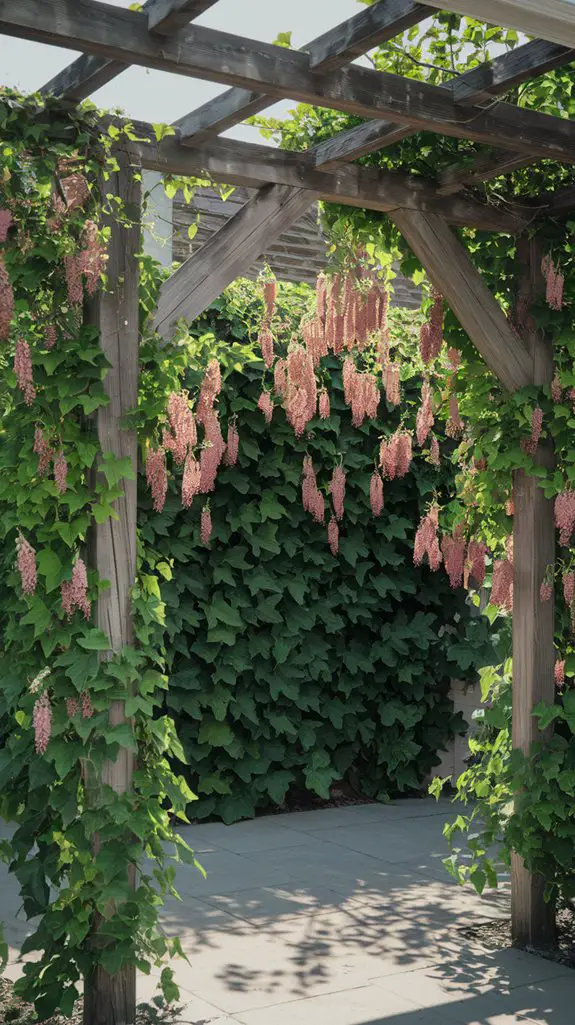
Beyond enhancing aesthetic beauty, climbing plants create natural privacy screens that transform exposed pergolas into intimate retreats. You'll find dense foliage varieties like ivy, clematis, and honeysuckle particularly effective at blocking unwanted views while still allowing dappled light to penetrate.
Consider strategic placement of climbing species to address specific privacy concerns. Fast-growing annuals like morning glory provide quick coverage during summer months, while evergreen options such as star jasmine offer year-round seclusion. Additionally, incorporating garden landscaping ideas can further maximize privacy and enhance the overall ambiance of your outdoor space.
When designing your living screen, account for mature growth patterns—some vines develop thicker coverage at specific heights. For maximum privacy, layer different climbing species with complementary growth habits.
Install trellises or mesh panels between pergola posts to provide additional climbing surfaces, creating a multi-dimensional green barrier that shields your outdoor sanctuary from neighboring properties.
Cooling Effects and Microclimate Benefits

Pergolas adorned with climbing plants create natural cooling systems that can considerably reduce surrounding temperatures during hot summer months. This natural air conditioning effect transforms your outdoor space into a comfortable retreat even during peak heat.
The microclimate benefits you'll experience include:
- Evapotranspiration from foliage reduces ambient temperatures by 4-8°F
- Dense canopies block 60-90% of solar radiation before it reaches pergola surfaces
- Increased humidity levels balance dry summer air conditions
- Air circulation channels created between leaves provide natural ventilation
- Reduced heat island effect minimizes reflected heat from surrounding hardscapes
You'll notice these cooling effects most prominently when selecting species with broad leaves and significant coverage. Additionally, using sustainable lawn care tips can enhance the overall health of your garden ecosystem.
Position climbing plants strategically on sun-exposed pergola sides to maximize shade during afternoon hours when temperatures peak.
Wildlife Attraction and Biodiversity Support
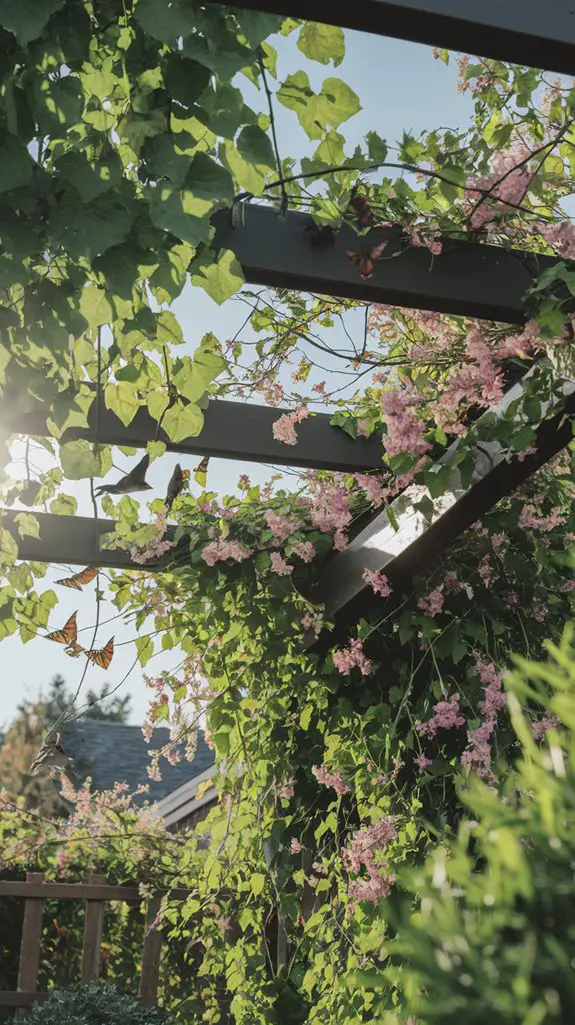
When selecting climbing plants for your pergola, consider their exceptional ability to attract diverse wildlife and enhance your garden's biodiversity. Flowering varieties like honeysuckle, wisteria, and trumpet vine serve as vital nectar sources for pollinators, including bees, butterflies, and hummingbirds. Dense foliage creates protective nesting sites for songbirds, while berries from climbers such as Virginia creeper provide essential food sources during migration and winter months. You'll create a functional ecosystem that supports predatory insects like ladybugs and lacewings, natural controls for garden pests. Additionally, incorporating native plant species into your garden can further increase wildlife attraction and support local ecosystems.
Vertical Gardening to Maximize Limited Space
Vertical gardening transforms your pergola into a space-optimization powerhouse, especially valuable in compact urban settings. By directing plant growth upward rather than outward, you'll create lush green spaces without sacrificing valuable square footage on your property.
- Utilize overhead space that typically remains unused in traditional garden layouts.
- Create visual barriers and privacy screens without installing permanent structures.
- Incorporate edible climbing plants like grapes or cucumbers for practical food production.
- Stack multiple plant varieties vertically to maximize biodiversity in minimal footprint.
- Implement automated drip irrigation systems along vertical supports for efficient watering.
This approach enables sophisticated layering techniques, where shorter plants occupy ground space while climbers fill vertical planes. Additionally, eco-friendly vertical gardening practices can enhance sustainability by promoting local biodiversity and reducing the need for chemical inputs.
Engineers and designers increasingly recommend vertical gardening solutions for urban residences where land constraints demand innovative spatial utilization strategies.
Structural Protection and Weather Buffering
Beyond their aesthetic appeal, climbing plants offer considerable structural benefits to pergolas, functioning as natural shields against environmental forces. Dense foliage creates a protective barrier that deflects harmful UV rays, preventing premature weathering of wooden pergola elements and extending their lifespan markedly.
You'll notice temperature moderation beneath your pergola once climbers establish themselves. In summer, the green canopy reduces heat gain by up to 80%, while winter-hardy varieties like ivy provide insulation against cold winds. This natural buffering can reduce your outdoor heating and cooling needs. Additionally, well-placed climbing plants can also help in noise reduction by acting as sound barriers, making your outdoor space more tranquil.
During rainfall, properly trained climbing plants direct water runoff away from your structure's core components. The root systems of established climbers can also stabilize surrounding soil, preventing erosion around pergola footings—particularly valuable on sloped properties where soil stability is vital.
Low-Maintenance Coverage Compared to Alternatives
Unlike artificial shade solutions that require regular replacement, climbing plants offer substantially lower lifetime maintenance costs while providing superior coverage for your pergola.
Once established, these living canopies need only seasonal pruning and occasional fertilization to maintain ideal growth patterns and density.
- Self-renewing coverage that repairs minor damage naturally, unlike fabric awnings requiring full replacement
- Adapts to your pergola's specific dimensions rather than requiring custom-fitted manufactured solutions
- Eliminates recurring costs of commercial shade products that deteriorate from UV exposure
- Creates microclimate cooling through transpiration instead of merely blocking sunlight
- Requires only water and minimal organic fertilizer versus synthetic materials that demand replacement every 3-5 years
In addition to their aesthetic benefits, climbing plants can significantly contribute to eco-friendly landscaping practices by enhancing biodiversity and supporting local wildlife.
The integration of climbing species into your pergola design strategically combines aesthetic appeal with practical functionality, reducing long-term resource expenditure while maximizing environmental benefits.
Fragrance and Sensory Experience Enhancement
Transforming your pergola into a multisensory retreat requires strategic selection of fragrant climbing species that release their scents at different times throughout the day and seasons.
Position jasmine or honeysuckle near seating areas where evening breezes activate their perfumes during outdoor dining. Wisteria offers cascading visual drama with its grape-like clusters while emitting sweet fragrance each spring.
Consider the sensory progression: morning-blooming clematis shifts to afternoon-opening roses, culminating with night-scented jasmine. This orchestrated olfactory experience extends your pergola's functional hours beyond purely visual appeal.
The gentle rustling of vine foliage introduces auditory elements, while textural diversity—from glossy star jasmine to velvety passion flower—invites touch interaction. Additionally, incorporating water features to attract backyard animals can enhance the overall experience by inviting more wildlife to your oasis.
You'll find this layered sensory approach creates a more immersive outdoor environment than hardscape elements alone could achieve.
Conclusion
You've invested thousands in a sophisticated pergola structure, yet it's the humble climbing plants that'll transform it into your garden's crown jewel. While you're obsessing over furniture and lighting, these living design elements silently work to shade, cool, and shelter your space year-round. Ironically, what requires the least investment delivers your pergola's most valuable asset—an evolving, breathing canopy that no manufactured solution could ever replicate.

